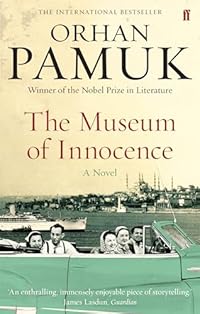Translated from the Spanish El amor en los tiempos del cólera by Edith Grossman.
Penguin, 2007, 348 p. First published by Editorial Oveja Nregra Ltda, Bogota, 1985.
The opening sentence, “It was inevitable: the scent of bitter almonds always reminded him of the fate of unrequited love,” hits us immediately with two of the great triumvirate of literary preoccupations; love and death. (Bitter almonds is the smell of cyanide.) The only one remaining is sex. Sex does come later but not till well into the book.
By this gambit we are invited to believe that the story is to be that of Dr Juliano Urbino de la Calle, who has been called in to certify the death (by suicide) of his friend and chess opponent Jeremiah de Saint-Amour. The main focus of the novel is, however, on Florentino Ariza, who conceived a passion for Dr Urbino’s wife, Fermana Daza, in both their youths, and has maintained it ever since. In some respects this aspect of the novel has echoes in Orhan Pamuk’s similarly obsessed protagonist in The Museum of Innocence.
The action of Love in the Time of Cholera mainly takes place in an unnamed city somewhere on the delta of the River Magdalena on the Caribbean coast of Colombia, though there is a late voyage up and down the river.
The narrative flows between the three main agonists, detailing aspects of their lives in the decades over which the story rummages back and forward. Marquez does nothing so crude as to devote sections to one character, he weaves in and out of the three’s concerns without a break. In the background are other colourful characters but the lives of these people are well-to-do, we see little, if any, of more impoverished inhabitants. Flashes of the history of the country, which has seen several civil wars which were really all one war, appear only in passing, which is, of course, how the well-to-do would have experienced them. Only by inference is the possibility of atrocities hinted at, for example, “For as long as I can remember, they have killed us in the cities with decrees, not with bullets.”
Joseph Conrad (in his pre-novelist incarnation as Joseph T K Korzeniowski) gains a brief mention as being involved in some sort of arms deal.
Interspersed through the novel Marquez gives us some acute aperçus.
“The toilet must have been invented by someone who knew nothing about men.”
“If he had told the truth not … anybody in this whole town would have loved him as much as they did.”
“… too young to know the heart’s memory eliminates the bad and magnifies the good,”
“… nothing in this world was more difficult than love.”
“Always remember that the most important thing in a good marriage is not happiness, but stability.”
“It is incredible how one can be happy for so many years in the midst of so many squabbles, so many problems, damn it, and not really know if it was love or not.”
“But when a woman decides to sleep with a man, there is no wall she will not scale, no fortress she will not destroy, no moral consideration she will not ignore at its very root.”
There was an instance of odd wording in the translation, “for he did compete not out of ambition for the prize, but” surely ought to be either, “for he competed not out of ambition, but…” or “for he did not compete out of ambition, but…”
Love in the Time of Cholera bears the stamp of a novelist who knows the inner workings of the human heart, its constancies (and inconstancies.)




